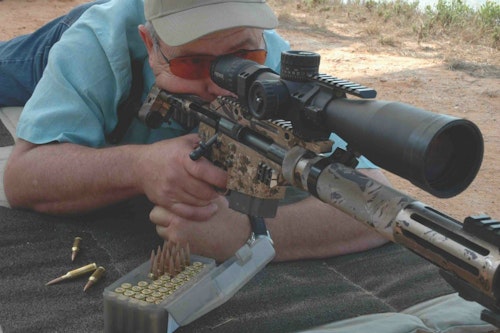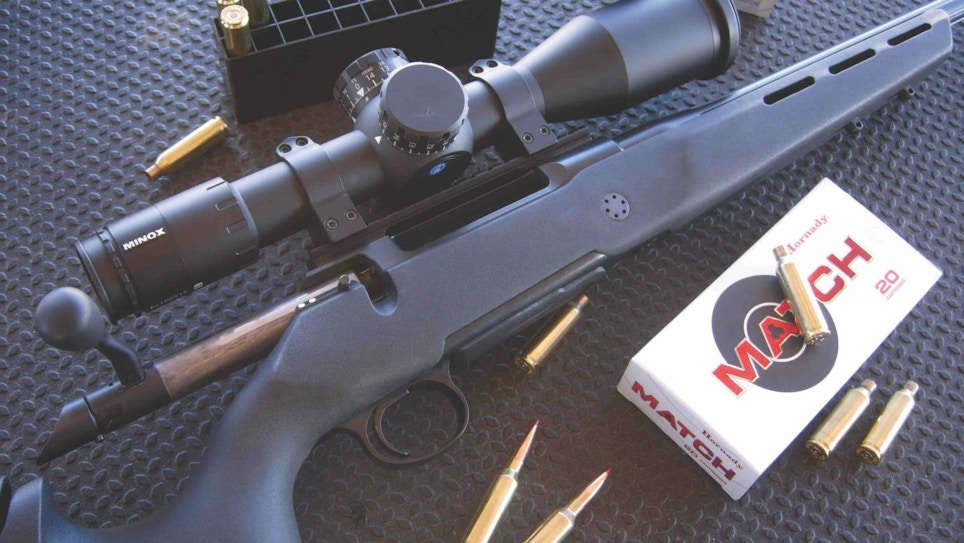“Addicting, isn’t it?” Kenny Jarrett grinned.
The first three shots from the .308 had cut a .2-inch delta, beating the trio from Jarrett’s Catbird (a 6mm/.270) by .1. At nearly .8, the .308 seemed naughty; but to miss deer vitals with a 3⁄4-minute rifle, you’d have to be shooting at over 1,400 steps.
“Let’s stretch ‘em to 600 yards,” said Kenny. After all, long reach had put ‘Beanfield Rifles’ on hunters’ radar. “I’ll call the wind.” So coached, I settled prone into grass bent by stiff breeze and triggered three shots from the .308. The Catbird trumped the resulting 5-inch group with a 4-inch. The .308 hurled three Trophy Bonded Bear Claws through the vitals of a life-size deer target.
Shooting Long Range
Long shooting has fascinated riflemen since muzzleloading days. But “long” isn’t what it used to be. The Hawken rifle (dating to 1825, when brothers Jake and Sam became partners in their St. Louis gun shop) long outlived the era of the Rendezvous. Francis Parkman, whose 1849 book, The California and Oregon Trail, chronicled early days beyond the Missouri, told of killing a pronghorn at 204 paces, and seeing another hunter drop a bison at nearly 300.
Remarkable! In a Feb. 21, 1920, article for the Saturday Evening Post (cited by Hanson in The Plains Rifle), Horace Kephart wrote of finding a new Hawken rifle that “… would shoot straight with any powder charge up to a one-to-one load, equal weights of powder and ball. With a round ball of pure lead weighing 217 grains, patched with fine linen so that it fitted tight, and 205 grains of powder, it gave very flat trajectory ...”
“Flat” is relative. The Australian sniper targeting a Taliban commander during Operation Slipper in Afghanistan in 2012 would have been ill served by a patched lead ball. A GPS unit measured the range at 3,079 yards! When he and a fellow sniper fired, the enemy soldier dropped.
I’m awed by this shot. It is exceedingly difficult to land a bullet in an 18-inch target a mile away. That’s 1,760 yards. At 3,000, a 3⁄4-minute error means a miss. Nearly 2 miles out, a bullet is descending steeply; it has likely met several wind conditions en route. A breeze that barely moves smoke can shove that missile many inches off course.
But deer hunters aren’t sandbagged with 12-pound rifles in .338 Lapua … Or are they? In some circles, long-range shooting has hijacked hunting. Nimble sporting rifles are conceding the field to heavy hunting/target hybrids. VLD bullets, chosen for their ballistic acumen downrange, carry enough punch to kill deer after leaking more than half their moxy to drag. The 3-9X scope is yielding to variables with 18X, 20X even 24X top ends.
As hunting becomes more costly and, in many places, more challenging, rifles with reach earn an audience. Focus on antlers ups the ante. What if the only mature buck you’ll see in seven seasons appears briefly at wood’s edge far away?
“Good gravy! Drop tines!” Jim crowded me for a better look through the aspens. “What a deer!”
It was indeed. We eased down our side of the canyon to reel in yards. As the buck minced across the slope opposite, another emerged, with typical but equally impressive antlers. We watched them walk toward a thicket. Jim could have fired — had there been a way to steady the Sako. But offhand, the muzzle bobbed without pause. A tough decision. Both were record-class deer. At last I said: “It’s over 300 steps. Best not shoot.” Jim lowered his 7mm. No matter the prize, distance or rifle, a risky shot is a risky shot.
Popular Long-Range Rifles and Cartridges
Rifles popular for deer hunting these days have far more reach than did the iron-sighted carbines in common use when a $30 SMLE tumbled my first deer. Most now are scoped bolt-actions chambered for rounds that shoot flat enough for a 200-yard zero. The .30-06 and .250 Savage, .270 and .257 Roberts predate WW II. The .308, .243, 6mm and .280 arrived in the ‘50s. A flurry of zippy cartridges followed, from Remington’s .25-06 and 7mm-08 to the currently beloved 6.5 Creedmoor. Magnums, wide-ranging in form and ballistic cachet, lengthen the list, as do Ackley, Gibbs and Mashburn wildcats and pre-WW I infantry rounds — .303 British, 7x57, .30-40 Krag and 8x57 — the nostalgic among us still adore.
The best deer cartridge, like the best deer rifle, is one you like and shoot well. But the prospect of long shooting trims options, even where “long” is still 300 yards.
I seldom shoot far at game. My first deer fell at 90 steps. At this writing, so did my last. I recall killing just one at over 400, a handful beyond 250.

Shots at Way-Out-There Coues
“I may shoot farther than most hunters,” David Miller told me. “But I don’t shoot farther than I can hit.” Miller hunts the diminutive Coues deer with a rifle of his own design, in .300 Weatherby. Called “the Marksman,” it’s now a commercial offering, a no-frills version of the fine classic custom rifles once the focus of Miller’s shop. “I’m fortunate because Curt Crum and I build rifles for a living. We’ve done it for 40 years. We use the best barrels and sights. We obsess over handloads.” Miller sorts hulls by weight and reams flash-holes. He favors long, sleek Sierra MatchKing bullets and spins them on a concentricity gauge “I mind details. Accuracy is a measure of uniformity.”
Scoped with a Leupold 6.5-20X featuring Miller’s rangefinding reticle, a Marksman has printed 2-inch groups for me at 400 yards. David concedes few hunters need or can tap that level of precision. “But Curt and I focus on trophy-class Coues bucks. You won’t see many of those in a season — maybe only one. Old deer seldom let you get close.”
Miller insists that diligent practice shooting has enabled him to take his best Coues deer. During the late 1980s and the 1990s, he killed six bucks that scored into Boone & Crockett’s records books. His closest shot at those deer was 450 yards. David attributes his success to diligent practice. “Just shooting isn’t useful. Every shot must be your best. Sloppy execution becomes habit. When Curt and I practice, we shoot as if one bullet was all we had.”
The Custom Route
Jarrett, Miller and other semi-custom shops — Brown Precision, Dakota/Nesika and H-S Precision — build long-range rifles that still handle nimbly. Sleek carbon-fiber stocks and barrels of standard contour keep weight to a manageable 8 pounds or so. Carbon-fiber barrels from the likes of Proof Research further reduce heft. Other makers sell hunters on heavier rifles with target-style stocks. The assumption is that they’ll be used from supported positions at deer stands or on canyon lips. Some stocks are shaped specifically for prone shooting — like those on the latest rifles by GreyBull Precision, founded by John Burns, Don Ward and Scott Downs. Before the 6.5 Creedmoor appeared, Remington 700-based GreyBull rifles wore stiff 26-inch Kreiger, Schneider and Lilja barrels in .243 and 7mm Remington Magnum. “With 105- and 180-grain VLD bullets, they’re all you need for the lower 48,” insisted John.
Wind-bucking bullets reach distant deer most reliably. But mulish kick is optional. Muscle-bound loads require that you either endure the battering or install a brake that makes your head ring. As violent rifles sell well, concussion must be addicting. I prefer mild loads that afford point-blank aim to 250 yards and deliver lethal energy — say, 1,000 ft.lbs — as far as I’ll send a bullet. The .243 and 6mm qualify. I’m sweet on the .25-06 and .270, the 7mm-08 and .280. The 7mm Magnum has an edge for elk-size game. GreyBull rifles I’ve used carried Leupold 4.5-14X VX III scopes, modified by Don with a simple but effective ranging reticle. Years before scope-makers listed “trajectory matched” dials, he was cutting arc-specific elevation knobs so shooters could “dial to the distance.” To kill a deer at 480 yards, you spin to 480 on the dial and hold center. Don replaces quarter-minute clicks with third-minute, “So you wring more distance from each dial revolution and reduce the chance for a full-rotation error.” GreyBull scopes have given me middle hits on steel at twice the range I’d fire at deer. I couldn’t resist John’s urging to try his .264 at a mile. Undulating prairie spun the breeze wickedly, and, over much of the distance, invisibly. John’s VLD bullets were vulnerable aloft for a full two seconds. If memory serves, my 14th shot scored. The smack of the bullet was five seconds getting back.

Closing In
Deer won’t stand for such nonsense. A first-round hit may be your only chance; it’s certainly the most efficient, humane way to kill a buck. My personal rule is to fire only when I'm 90 percent sure of a fatal hit. A short shot trumps a long one. Odds of missing and crippling increase with yardage. Getting close to a deer adds challenge and excitement; it’s the difference between hunting and shooting. When someone boasts of killing with a long shot, I’m tempted to say, “Cheer up; you’ll get closer next time.”
Sidebar: A Hard Push
Studying bullets in flight has always been hard, because you can’t see them. But in 1740 a clever Englishman, Benjamin Robins, invented a pendulum-like device to measure bullet speed. It had a heavy bob of known weight. Noting the height of the swing when the pendulum was struck by a bullet of known weight, he was able to calculate impact speed. His data showed 75-caliber musket balls flew at 1,400 to 1,700 feet per second. Skeptics scoffed. How could anything travel so fast? When Robins increased firing distance, his results drew even more criticism. To explain those readings, he concluded that air resistance was 85 times as strong as the force of gravity. Now that was a hard concept to sell — but, of course, it was true.
Sidebar: Bullets With Long Legs
VLD (very low drag) bullets are simply long, racy-looking bullets. Heavy for the bore, they can’t be driven as fast as lighter bullets. But they retain velocity better. Indeed, a fast launch increases drag and deceleration rate. At long range the VLD bullet will overtake and pass a lighter missile. A long ogive (the bullet’s nose between tip and shank) reduces drag. But long bullets require steep rifling twist to stabilize in flight, and must be seated deep to fit ordinary rifle magazines.







